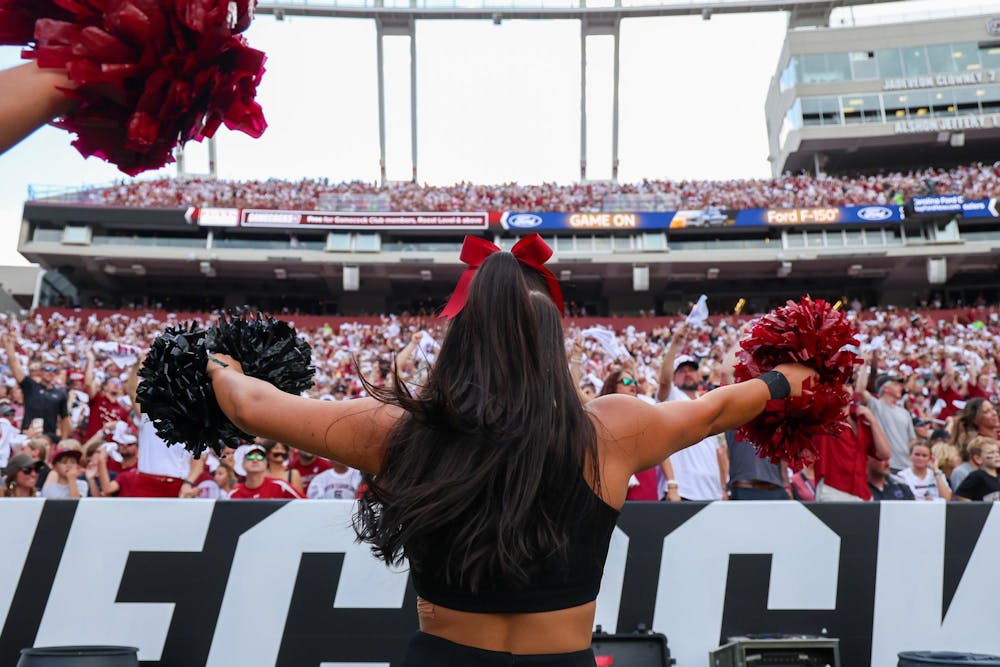USC cheerleaders are focused on making fans' gameday experiences, and the coaches aim to improve the tryout process for future cheerleaders, according to fourth-year public health student Holley Doyle.
The road to an SEC cheerleading program, such as the University of South Carolina's, is often overlooked, Doyle said. She said it takes high-level skills and dedication to make a lasting impression on the coaches before in-person tryouts start.
"Cheerleaders are a big face in athletics, because we cheer for so many sports and we do so many appearances and stuff, sometimes I don't think we get the recognition we deserve," Doyle said.
The team is divided into two sections, with an all-girls team and a co-ed team to showcase different skills. The two teams work together to make gameday more fun for fans by arriving early to ensure fans can get stickers and pictures at games, Doyle said.
The process to become a cheerleader takes time and dedication when deciding what schools they want to apply to. Some athletes apply to USC only for cheer, while others apply because of the atmosphere and academic programs that are offered.
Second-year nursing student Peter Williams said staying in state, academic program and cheer all played a role in choosing what college he would apply to.

“At the end of the day, with my education, I wanted to cheer,” Williams said. “So wherever I did cheer, it had to have a good game day, good coaching, good program, just everything that I could want in a cheer program.”
Mackenzie Buffo, a graduate secondary education student, said she did not initially plan to try out for cheer because she was a long-time gymnast and only started cheer in high school, but looking at USC's cheer program changed her mind.
“I started exploring the cheer program, and I really enjoyed what I saw,” Buffo said. “They looked like they had fun on the sidelines, and I really liked the competitive part of it, of how they still competed at NCAA college nationals, because I like competing, and I like an adrenaline rush.”
Cheer was the main consideration for some students when applying to USC. Fourth-year public health student Anna Ruff said she has always wanted to be a South Carolina cheerleader because she grew up as a fan and wanted to stay in-state.
“I've been cheering since I was four, so I kind of (have) been preparing for this my whole life,” Ruff said, “I was already on dead mat for six years, and then I just got a stunt group, and we taught ourselves all of (the) college skills because I never did those really in high school.”
Head coach Logan Lefler said tryouts are highly competitive, and he is looking to recruit athletes while they are in high school, rather than having them tryout when they get to USC. In the current tryout process, students submit a video and may be selected to attend the in-person tryout, where final decisions are made.
When athletes are trying out, Lefler said he looks for factors other than talent to be placed on the team. Work ethic and how athletes “vibe” with the team are important because they matter a lot more in practices and games, Lefler said.
“At the end of the day, skills matter the most at nationals, which is one weekend out of the year, and they help our game day look better, but it's not the bulk of what we're doing,” Lefler said.
Fourth-year public health student Makaila Mann said the tryouts can be nerve-racking for athletes experiencing social anxiety because they have not met each other yet and have to pick their own stunt partners.
“You have a panel of people just watching you. It was so stressful, and you have one shot,” Mann said.
Doyle said the tryout process was intimidating due to the different skill levels, and she prepared by attending several clinics offered .
“Cheering on the sideline in high school is a lot different than cheering on the sideline in college,” Doyle said. “High school is more chants and everything, but in college, we've got sign work, we've got stunts in our songs, we have tumbling in our songs, and it's more of a routine dance.”
Lefler said the co-ed team is looking at finding more boys and that a standard, more direct recruitment process without "guesswork" will help improve the team in the long-run.
"For a lot of people, just to know that they could have a place earlier (and) not have to wait," Lefler said. "Being a little more forward thinking, open to offering some of the younger athletes just to let them know that we're taking our growth seriously, that we're already thinking about four years from now."
Information regarding appearances and clinics will be released throughout the school year, Lefler said. This year, dates and times will be available earlier than in the past, according to Lefler.

